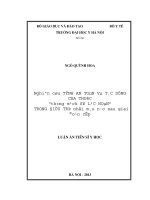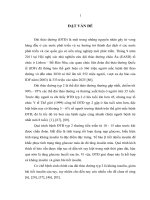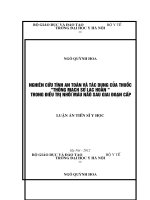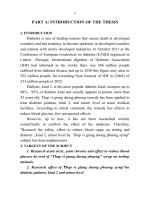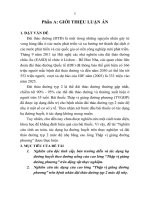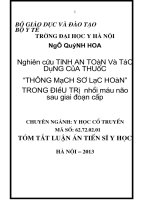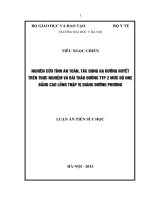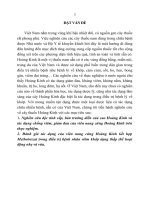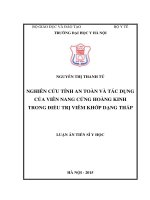nghiên cứu tính an toàn, tác dụng hạ đường huyết trên thực nghiệm và đái tháo đường typ 2 mức độ nhẹ bằng cao lỏng thập vị giáng đường phương bản tóm tắt
Bạn đang xem bản rút gọn của tài liệu. Xem và tải ngay bản đầy đủ của tài liệu tại đây (212.54 KB, 25 trang )
1
PART A: INTRODUCTION OF THE THESIS
1. INTRODUCTION
Diabetes is one of leading reasons that causes death at developed
countries and has tendency to become epidemic in developed countries
and nations with newly developed industries. In October 2011 at the
Conference of European researchers on diabetes (EASD) organized in
Lisbon –Portugal, International dignities of Diabetes Association
(IDF) had informed in the world, there was 366 million people
suffered from diabetes disease and up to 2030 this figure may arise to
552 million people, far exceeding from forecast of IDF in (2003) of
333 million people in 2025.
Diabetic, kind 2, is the most popular diabetic kind, occupies up to
90% - 95% of diabetic kind and usually appears at person more than
35 years old. Thap vi giang duong phuong remedy has been applied to
treat diabetes patients, kind 2, and minor level at some medical
facilities. According to initial comment, the remedy has effects to
reduce blood glucose, few unexpected effects.
However, up to now, it has not been researched overall,
scientifically to confirm the effect of the medicine. Therefore,
"Research the safety, effect to reduce blood sugar on testing and
diabetic , kind 2, minor level by Thap vi giang duong phuong syrup"
subject has been implemented.
2. TARGETS OF THE SUBJECT
1. Research acute toxic, semi chronic and effect to reduce blood
glucose by oral of “Thap vi giang duong phuong” syrup on testing
animals.
2. Research effect of "Thap vi giang duong phuong syrup" on
diabetic patients, kind 2 and minor level
2
PRACTICAL SIGNIFICANCE AND NEW CONTRIBUTION OF
THE THESIS
Scientifics work of the thesis to research rather systematically both preclinic and clinic one traditional medical remedy to treat diabetic, kind 2.
Researching results shows: Oral Thap vi giang duong phuong
syrup has high safety, effect to reduce glucose, amend blood lipids
disorders on testing animals as well as on diabetic patients, kind 2,
minor level and no clinical unexpected effect is noticed. The research
on application of traditional medicine in diabetic, kind 2, minor level
treatment contributes to clear traditional medicine theory and
gradually modernize traditional medicine is the work with practical
scientific significance. Especially, our country is one nation with
customs depth in using traditional medicine to take care the health of
community; results of thesis's subject are new and quite practical
contribution.
The structure of the thesis:
Besides the introduction and conclusion, the thesis has 4 chapters:
Chapter 1: Overview of documents
39 pages
Chapter 2: Objectives and researching method
20 pages
Chapter 3: Researching results
34 pages
Chapter 4: Discussion
33 pages
The thesis has: 52 tables, 3 diagram, 6 images, 3 diagrams and
annexes, 114 referential documents (Vietnamese language: 44,
English language: 47, Chinese language 23).
3
PART B: THE CONTENT OF THE THESIS
CHAPTER 1: OVERVIEW
1.1. DEFINITION, DISEASE GENERATING SYSTEM, DIANOSIS STANDARD
AND TREATMENT OF DIABETE KIND 2 BY MODERN MEDICINE.
* Definition and classification of diabetes
According to the definition of American Diabetes Diagnosis and
Classification: "Diabetes is one metabolism disease group with the
attribution of increasing blood glucose, results of insulin shortage,
default in insulin action; or both. Increasing of chronic glucose usually
combines with destroy, disorder and weakening functions of many
organs, especially eyes, kidney, nerve system and blood vessels”.
According to the classification of America Diabetes Association in
2011, diabetes is divided into 4 kinds: Diabetes kind 1, diabetes kind 2,
maternity period diabetes and other special blood glucose increasing
kinds, in which diabetes kind 1, diabetes kind 2 are most popular ones.
* Disease generating mechanism of diabetes kind 2
Disease generating mechanism of diabetes kind 2 relates to the
rather shortage of insulin, mainly due to insulin generating disorder
and anti- insulin phenomenon. In which the insulin generating disorder
and anti- insulin has close relationship to each other and both happen
before the appearance of other clinical manifestation of diabetes (prediabetes period). On diabetes patient kind 2 without weight exceeding,
insulin reduce manifestation is main, on the contrast, on diabetes
patient kind 2 with obesity; anti- insulin is the main symptom.
Treatment of Diabetes kind 2
Treatment methods comprise the amendment way of living (diet
and physical exercise) and taking medicine.
Currently, medicine for diabetes kind 2 treatment focuses on the
group: medicine to excite insulin excretion (sulfonylurea, meglitinid),
medicine to increase the sensitive of objective cell with insulin (iguanid
deviation, thiazolidinedion group), enzyme α glucosidasecytic, medicine
to restrict co-transport Na+/glucose substance at kidney larynx).
4
1.2. REASONS, DISCEASE GENERATING, SYMTON AND TREATMENT
PRINCIPLES ON DIABETES KIND 2 ACCORDING TO TRADITIONAL
MEDICINE
Traditional medicine has no name for diabetes disease, their
manifestations belong to phenomenon of "thirsty digestion" caused by
many reasons, on clinical, it has symptoms such as much drinking,
much eating and much urinate, very thin and tired or urine water has
sweet taste which are symptoms of the disease.
Reason that causes to the thirsty digestion relating to the illness of
the five inner parts innards, exciting spirit, temper is unbalance or
eating too much sugar, lipid and the body is alimentary obesity.
The nature of thirsty digestion is damaged inner parts - heat and
constipation that directly effect to inner parts which are: lung, kidney,
and spleen, liver. Common treatment method is: Lung aperients foster liver - strengthen kidney - generating nutrient to reduce thirsty.
1.3. THAP VI GIANG DUONG PHUONG MEDICINE
Composition of "Thap vi giang duong phuong" medicine
No
.
1.
Name of medicines (drug)
Content
Radix Glehniae
16g
2.
Radix Dioscoreae Popositae
20g
3.
Radix Rehmanniae glutinosae praeparata
20g
4.
Fructus lycii
20g
5.
Radix Salviae multiorrhizae
30g
6.
Radix trichosantes
16g
7.
Fructus Alpena oxyphyllae
15g
8.
Semen Euryales
20g
9.
Rhizoma Anemarrhenae
5g
10.
Rhizoma Smilacis glabrae
30g
5
- Effect: Generating nutrients to prevent thirsty, foster inner parts.
- Modern researching results shows that medicine components of
Thap vi giang duong phuong medicine all contains chemical
compositions that have effect to reduce blood glucose practically.
- The remedy has been applied to treat diabetes patients on
clinical, initially it has effect to reduce blood glucose and improves
some clinical symptom such as much eating, much drinking, much
urinate and tiredness.
CHAPTER 2: MATERIAL OF OBJECTIVES AND
RESEARCHING METHOD
2.1. RESEARCHING MATERIAL (STUFF)
2.1.1. Medicine to be reached on testing
Thap vi giang duong phuong is used in toxic research and
pharmaceutical effect have been produced under thick syrup 3:1 at
Pharmaceutical Department - Ha Dong traditional Medicine Hospital.
2.1.2. Medicine on clinical research
Thap vi giang duong phuong is infused by automatic infusion
machine, each medicine parcels is infused into 2 bags, each bag is
192ml manufactured by Ha Dong traditional medicine Hospital
attaining basic standard.
2.2. RESEARCHING OBJECTIVE
2.2.1. Research on testing animals
Animals used in the research: 160 Swiss white mice from 6 - 8
weeks old, weight is from 18 - 22g, 30 grown up rabbits, New
Zealand White species, both genders, weight of 2,0 ± 0,2 kg. Testing
animals are feed in enough food and water conditions at laboratory of
Pharmaceutical Department of Hanoi Medical University from 3 - 7
days before and during all researching period.
2.2.2. Research on clinical research
6
120 patients both genders are diagnosis to be diabetes type 2,
minor level according to diabetes diagnosis standard of American
Diabetes Association in 1998 and classification of disease levels due
to Thai Hong Quang 2001. The patients are treated at Health Care
Center of Thanh Tri district, Hanoi City.
* Criteria to select patients for research:
In this research, selected patients at both genders are diagnosed to
be diabetes kind 2, minor level spontaneously participate in the
research. The patients have cease to use diabetes medicine treatment
before taking researched medicine 2 weeks, or the ones who are newly
discovered diabetes kind 2, minor level have been treated by diet and
physical exercise regimes but no result is generated.
* Criteria to eliminate from research scale:
Diabetes patient kind 1 Pregnant and breeding women diabetes
kind 2, average and serious levels.
+ The patient has pernicious side effect of diabetes such as:
Diabetic ketoacidosis, coma with increased absorb pressure increase,
serious infection, hepatic failure, renal failure and heart failure.
+ The patients has prehistory: Myocardial infarction, chest angina,
coronary arteries insufficiency, cerebra-vascular accident (CVA) Do
not select endocrine disease patients Basedow, Cushing diseases, big
end of limbs, myeloid leukemia, adrenal rest patients.
+ Diabetes patients type 2 with minor level but treatment diagram is
not implemented: Do not take medicine, go to business for a long time,
acute diseases, and self use other diabetes medicine for treatments.
2.3. RESEACHING METHOD
2.3.1. Research acute toxic, semi chronic and effect to reduce
blood glucose by oral of Thap vi giang duong phuong syrup on
testing animals.
* Research pernicious toxic, semi chronic
7
Pernicious toxic to be confirmed on white mouse by oral taking
due to Litchfield - Wilcox on method: Thap vi giang duong phuong
syrup dose 45g medicine material /kg body weight /24 hours to highest
dose that mice can drink 225g medicine material /kg body weight /24
hours (at different doses that may provide for mouse to drink 2 or 3
times to attain maximum cubit dimension to be able to drink within 24
hours). To follow up 1 week on health conditions, operation, digression,
death or alive. Comparison to taking of poured distilled water.
- Test toxic on semi chronic: to carry out on rabbit with dose 11,52
g/kg/day (equivalent to dose used on human being, calculated by 3rd
coefficient) and dose 34,56 g/kg/day (3 times higher than dose used on
human being) during test time of 12 weeks. To follow up weight, eating,
sleeping, digestion, biochemical function of liver, kidney, tissue disease
of liver and kidney. Comparison to taking of poured distilled water.
* To research glucose reduce and blood lipid effect of Thap vi giang
duong phuong syrup on tested white mouse.
- To research glucose reduce and blood lipid effect of Thap vi
giang duong phuong syrup on tested diabetes white mouse, type 2:
diabetes white mouse, type 2, obesity by rich nutria energy from lipid
and fructose (HFD regime) in 12 weeks, then give Thap vi giang duong
phuong syrup for mice to take orally dose 38,4g/kg and dose 76,8g/kg
within 20 days. Carry out weight testing of mouse, take peripheral blood
testing to carry out the identification of blood glucose content when
being hungry and blood lipid index (complete cholesterol (TC),
triglyceride (TG), HDL-Cholesterol, LDL-Cholesterol) at all batches at
period before, after 12 weeks of generating models and after 20 days of
taking medicine. Results are compared with mouse taking orally
gliclazid dose 30mg/kg, mice with diabetes kind 2 without using
medicine and bio counterpart comparison.
8
- To research standby treatment effect on diabetes kind 2 of Thap
vi giang duong phuong syrup on white testing mice: white testing
mice eats rich energy food regimes (HFD regimes) at the same time,
orally taking Thap vi giang duong phuong syrup dose 38,4g/kg and
dose 76,8g/kg during the time of 8 weeks. To carry out the weight
checking of mice, take peripheral blood testing carry out the
identification of blood glucose content when being hungry and blood
lipid index (complete cholesterol (TC), triglyceride (TG), HDLCholesterol, LDL-Cholesterol) at all batches at period before, after 8
weeks. Results are compared with mouse taking orally gliclazid dose
30mg/kg, mice with rich energy regimes (HFD regimes) without using
medicine and bio counterpart comparison.
2.3.2. Research on clinical research
Open clinical research - testing - compare results before and after
treatment.
The research was implemented on 120 patients both genders are
diagnosis to be diabetes type 2, minor level according to diabetes diagnosis
standard of American Diabetes Association in 1998 and classification of
disease levels due to Thai Hong Quang 2001. The patients are treated at
Health Care Center of Thanh Tri district, Hanoi City.
Medicines and usage: patients take orally Thap VI giang duong
phuong syrup infusion type: 2 bags (1 medical remedy). /1 day
dividing into 2 times: morning and afternoon in 90 days.
Researching content:
- Patients are medical examined over ally on clinic by modern
and traditional medicines, to do para-clinical tests before researching.
Patients are regularly check blood glucose and periodical medical
examination 2 weeks/1 time, after that they are given medicines and
using guidances on days D0, D15, D30, D45, D60, D75, D90.
9
-
Patients in researching scope do not use other medicine and to
be guided to implement one eating regimes, physical exercise while
being treated (with menu and attached exercises).
Outcome appraisal method:
Subjective symptoms Test 15 days /1 time on (D0, D15, D30, D45,
D60, D75, D90) based on main symptoms on eating, drinking, urinating,
tiredness, going to stool, sleeping. Objective symptoms are evaluated
at periods (D0, D30, D60, D90) according to marking form by table (2.5.)
Subjective symptoms to be evaluated via weight, blood tension:
+ To identify weight index (BMI) by the regulation of WHO (1990).
To evaluate BMI results according to standards of ASEAN 2001
nations: Thin: <18, 5; normal: 18, 5 - 22, 9; overweighed ≥ 23 (with
risk: 23 - 24, 9, obesity level 1: 25 - 29, 9, obesity level 2: ≥ 30).
+ To evaluate blood pressure increasing (applied for adults from
18 years old): based on the standards of JNC VI (Six Report of the
Joint National Committee on the Prevention, Detection, Evaluation
and Treatment of High Blood Pressure).
- Subclinical criteria’s:
+ Index of peripheral blood cell: to be confirmed on CD - 1700
machines of ABBOTT (American) company, comprising indexes: the
number of erythrocyte (T/L), Leukocyte quantity (G/L), blood plaque
quantity (G/L), ferrochrome (g/L), Hematocrit (%).
+ Biochemical tests are implemented before and after treatment on
Hitachi – 704 (Japanese) automatic biochemical machine comprising
indexes: Creatinin, AST, ALT, Cholesterol, Triglyceride, and HDL Cholesterol, LDL - Cholesterol.
+ Glucose blood testing on capillary is implemented on treatment
days D0, D45, D30, , D60, D90.Criteria to evaluate blood glucose reduce:
10
Good:
Blood glucose 4, 4 - 6,1 mmol/l
Acceptable:
Blood glucose 6, 2 - 7,0 mmol/l
Poor:
Blood glucose > 7,0 mmol/l
+ Urinate testing: Urinary’s, protein, urinate cetin.
+ HbA1c content: to be implemented on Imx machine of
ABBOTT company, HbA1c normal: 3,0 - 6,5%.Result evaluation:
according to ASEAN 2002 national standards.
- To follow up unexpected effect: vomiting attempt, vomiting,
bellyache, itching…
- Evaluation of general treatment effect. Based on clinical, subclinical
symptoms to classify into: good, fair, average and poor types.
2.4. DATA PROCESSING
- Database is analyzes by bio medical statistics method on the
computer under the assist of software SPSS 13.0.
- Used mathematic methods:
+ In average: ( X ), standard discrepancy (SD)
+ Calculate percentage proportion (%)
+ To compare two average number in one researching batch
between interval periods by pair comparison method.
+ To compare two average numbers between two groups to each
other at one period by mathematics method s Student-T-test and
mathematical proportion χ2.
CHAPTER 3: RESEARCHING METHOD
3.1. SEARCHING RESULTS ON PERNICOUS TOXIC, SEMI CHRONIC
WITH EFFECT TO REDUCE GLUCOSE AMENDMENT OF
BLOOD LIPID BY ORAL TAKING OF THAP VI GIANG
DUONG PHUONG SYRUP ON PRACTICE
3.1.1. Result on pernicious toxic research (LD50)
11
Maximum taking dose 225g/kg body weight of mice, 6 times
higher than effective doses and 58 times of estimated dose used on
human, has no pernicious toxic manifestation.
3.1.2. Result on pernicious toxic research on semi chronic
Dose of 11,52g/kg/day (equivalent to dose used on human being)
and dose 34,56g/kg/day (three times higher than dose used on human
being), taking orally continuously in three months, there is no change
on hematology index, hematology biochemical indexes and liver tissue
disease of rabbit’s kidney.
3.1.3. To research glucose reduce and blood lipid effect of Thap
VI giang duong phuong syrup on practice.
First batch: Sample batch: NFD regime + drinking distilled water
Second batch: HFD regime + drinking distilled water
Third batch: HFD regime + taking gliclazid dose 30mg/kg
Fourth batch: HFD regime + taking Thap vi giang duong phuong
syrup dose 38.4g/kg
Fifth batch: HFD regime + taking Thap vi giang duong phuong
syrup dose 76.8g/kg
- In discrepancies to biological batch (first batch) *: p ≤ 0, 05; **:
p ≤ 0, 01; ***: p ≤ 0,001
- In discrepancies to model batch (second batch) Δ: p ≤ 0, 05; ΔΔ:
p ≤ 0, 01; ΔΔΔ: p ≤ 0,001
3.1.3.1. Researching results on glucose reduce and blood lipid
effect of Thap vi giang duong phuong syrup on practice.
Table 3.11 Effect of Thap vi giang duong phuong syrup on weight of mice
Weight of the mouse
Researching
Before
After 20 days of
batch
After 12 weeks
researching
taking medicines
First batch
20,90 ± 0,99
27,80 ± 2,44
31,40 ± 3,10
Second batch 20,50 ± 1,51 35,40 ± 4,67*** 38,70 ± 3,30***
Third batch
20,50 ± 1,51 28,40 ± 4,22***
29,10 ± 2,13ΔΔΔ
Fourth batch 20,20 ± 1,32 34,60 ± 4,22***
36,50 ± 3,41
Fifth batch
20,50 ± 1,43 35,30 ± 3,37***
35,80 ± 2,82Δ
Comments: Results of table 3.11 proves the weight of mice increase highly
at HFD eating regime in comparison to bio sample batch with (p < 0,001).
12
Weight of mice at gliclazid taking and testing medicine has reduced
tendency in comparison to sample model batch, especially reducing level at
gliclazid taking of 30mg/kg and Thap vi giang duong phuong syrup high
dose in comparison to batch 2 with (p<0,001 and p < 0,05).
Table 3.12 Effect of Thap vi giang duong phuong syrup on glucose
blood content of mice
Blood glucose content (mmol/L)
Researching
Before
After 20 days of
batch
After 12 weeks
researching
taking medicines
First batch
4,77 ± 0,68
4,85 ± 0,45
4,69 ± 0,58
Second batch 4,59 ± 0,48
10,85 ± 0,62*** 10,68 ± 0,81***
Third batch
4,75 ± 0,53
10,78 ± 0,64***
6,30 ± 0,48ΔΔΔ
Fourth batch
4,71 ± 0,52
10,51 ± 0,71***
7,83 ± 0,51ΔΔΔ
Fifth batch
4,50 ± 0,45
10,73 ± 0,83***
7,85 ± 0,65ΔΔΔ
Comment: Results of table 3.12 proves the blood glucose content of
mice increase significantly at HFD eating regime in comparison to bio
sample batch with (p < 0,001). Thap vi giang duong phuong syrup of
two oral doses used continuously after 20 days has effect to reduce
blood glucose content in comparison to sample model batch (p < 0,001).
Glucose reducing effect of Thap vi giang duong phuong syrup is
similar to reducing effect of gliclazid dose 30mg/kg.
Table 3.13 Effect of Thap vi giang duong phuong syrup on lipid blood
content of mice
Researching
TG
HDL-C
TC
LDL-C (mg/dl)
batch
(mg/dl)
(mg/dl)
(mg/dl)
First batch
1,08 ± 0,14
0,52 ± 0,08
2,32 ± 0,25
1,58 ± 0,21
Second batch 1,87± 0,50*** 0,74± 0,21*** 4,12 ± 0,63*** 3,01 ± 0,73***
Third batch 1,32 ± 0,22ΔΔ 0,82 ± 0,19
3,90 ± 0,75
2,81 ± 0,77
Δ
Fourth batch 1,60 ± 0,46
0,82 ± 0,18
3,55 ± 0,33
2,41 ± 0,30Δ
Fifth batch
1,26 ± 0,37ΔΔ 0,74 ± 0,23
3,68 ± 0,44
2,69 ± 0,59
Comment: The results of table 3.13 shows lipid disorder conditions of
batch No.2 (model batch) in comparison to sample batch, presents at
high increasing level of all indexes TG, HDL-C, TC, LDL-C R batch 2
in comparison to model batch with p < 0,05. TG reduced level has
statistic meaning at oral gliclazid medicine batch (batch No.3) and
13
Thap vi giang duong phuong syrup taking at high dose (batch No.5)
(p < 0,01), TC reducing and LDL-C has statistic meaning at oral Thap
vi giang duong phuong syrup taking at low dose (batch 4) (p < 0,05).
3.1.3.2. Research results on standby effect on diabetes kind 2
treatment of thap vi giang duong phuong syrup on white mouse
Table 3.14 Effect of Thap vi giang duong phuong syrup on weight of mice
Weight of the mouse
Researching batch
Before researching
After 8 weeks
First batch
21,61 ± 1,14
26,89 ± 1,05
Second batch
21,63 ± 1,51
29,88± 2,75***
Third batch
21,25 ± 1,78
26,40 ± 2,27ΔΔ
Fourth batch
21,42 ± 2,32
25,75 ± 5,79ΔΔ
Fifth batch
20,29 ± 1,63
26,00 ± 4,20ΔΔ
Comment: Results of table 3.14 proves the weight of mice increase
highly at model (batch 2) in comparison to bio sample batch with (p <
0, 01). Weight of mouse at gliclazid oral medicine and testing
medicines have reduced tendency in comparison to model batch in
comparison to batch No.2 with (p < 0, 01).
Table 3.15 Effect of Thap vi giang duong phuong syrup on glucose
blood content of mice
Blood glucose content (mmol/L)
Researching batch
Before researching
After 8 weeks
First batch
5,53 ± 0,56
5,40 ± 0,79
Second batch
5,49 ± 0,67
10,46 ± 0,58***
Third batch
5,27 ± 0,56
6,30 ± 1,03 ΔΔΔ
Fourth batch
5,28 ± 0,49
6,78 ± 0,93 ΔΔΔ
Fifth batch
5,10 ± 0,43
6,21 ± 1,46 ΔΔΔ
Comment: Results of table 3.15 proves the blood glucose content of mice
increase significantly in comparison to bio sample batch with (p < 0,001).
Thap vi giang duong phuong syrup of two oral doses used
continuously after 8 days has effect to reduce blood glucose content in
comparison to sample model batch(p < 0,001). Glucose reducing
14
effect of Thap vi giang duong phuong syrup is similar to reducing
effect of gliclazid dose 30mg/kg with (p>0.05)
Table 3.16 Effect of Thap vi giang duong phuong syrup on lipid blood
content of mice
Researching
batch
TG (mg/dl)
HDL-C
(mg/dl)
TC (mg/dl)
LDL-C
(mg/dl)
First batch
1,84 ± 0,35
1,57 ± 0,34
4,41 ± 0,26
2,48 ± 0,50
Second batch 2,71 ± 0,32*** 2,09 ± 0,46* 5,60 ± 0,36***
Third batch
Fourth batch
Fifth batch
ΔΔΔ
1,92± 0,18
1,89±0,20
ΔΔΔ
1,90±0,23
ΔΔΔ
1,66 ± 0,30
Δ
Δ
1,66 ± 0,28
1,80 ± 0,26
4,83 ± 0,55
2,79 ± 0,50
Δ
3,08 ± 0,50
ΔΔ
2,81 ± 0,29
5,12 ± 0,45
4,99 ± 0,42
2,97 ± 0,67
ΔΔ
Comment: The results of table 3.16 shows lipid disorder conditions of
batch No.2 (model batch) in comparison to sample batch, presents at high
increasing level of all indexes TG, HDL-C, TC, LDL-C R batch 2 in
comparison to model batch with p < 0,001. Blood lipid disorder
(RLLPM) at gliclazid oral taking batch and Thap vi giang duong phuong
syrup have been improved with significance reduces of TG, TC content of
oral medicine batch in comparison to model batch with (p < 0,05).
3.2. CLINICAL RESULTS
3.2.1. General attributions of researched patient
3.2.1.1. Distribution of patients by ages and gender
Proportion %
15
Diagram 3.1 Distribution of patients by ages (n=120)
16
Gender
Table 3.18 Distribution of patients by gender
Common
patient
Gender by traditional medicine
(n=120)
n
Man
Woman
p
%
26 21,7
94 78,3
<0,001
Lower
Medium
Upper
digestion part digestion part digestion part
n
%
10
26,3
28
73,7
<0,001
n
%
8
20,0
32
80,0
<0,001
n
P
%
8
19,0
34
81,0
<0,001
>0,05
>0,05
Comment: Proportion of woman patients is higher than male patients with
statistic significance in total amount of patients and in each kind of disease
by traditional medicine with p<0,001, gender proportion between types by
traditional medicine has no statistic meaning with p>0, 05.
3.2.2. Treatment results due to modern medicine
Table 3.23 Results on changing of clinical symptoms before and
after treatment (n=120) evaluated by table 2.5
D0 (n = 120)
SL, %
Symptom
Norma
l
Much
18
drinking
15%
17
Much urinate
14,1%
59
Eating a lot
49,1%
27
Tired
22,5%
57
Sleepless
47,5%
Insensitive
118
skin
98,3%
45
Sweating
37,5%
64
Constipation
53,3%
116
Opaque eyes
96,7%
113
Headache
94,2%
SL, % SL, %
Good Fair
56
46,6%
63
52,5%
51
42,5%
91
75,8%
63
52,5%
2
1,7%
74
61,7%
56
46,7%
3
2,5%
5
4,2%
46
38,3%
40
33,3%
10
8,4%
2
1,7%
0
0
1
0,8%
0
1
0,8%
2
1,6%
D90 (n = 120)
SL, %
SL, %
Norma
Poor
l
0
116
0
96,7%
93
0
77,5%
119
0
99,2%
119
0
99,2%
118
0
98,3%
120
0
100%
106
0
88,3%
118
0
98,3%
120
0
100%
120
0
100%
SL, % SL, % SL, %
Good Fair
Poor
4
3,3%
27
22,5%
1
0,8%
1
0,8%
2
1,7%
0
0
0
0
0
0
0
0
0
0
0
0
0
0
0
0
0
0
0
0
0
0
0
14
11,7%
2
1,7%
17
Comment: Results of table 3.23 shows that most of clinical symptom
after 90 days of treatment has come to normal, 100% attain good
condition and fair, no poor and average levels.
Table 3.24 Blood glucose index (mmol/l) and HbA1c (%)
Indexes
(X±SD)
P
D0
D30
D60
D90
Blood
glucose
(n =120)
8,02±0,73
6,80±0,78
6,29±0,67
6,00±0,66
(D0/30)<0,001
(D0/60) <0,001
(D0/90) <0,001
HbA1c
7,25±0,84
-
-
6,23±0,94
(D0/90) <0,001
Comment: Checking point of reduced blood glucose has statistics
meaning since the 30th days after the treatment, after 90 days of
treatment of general blood glucose to turn to normal conditions (p 90-0
< 0,001). After 90 days of treatment, HbA1c index (%) reduces, the
changes have statistics meaning (p90-0 < 0,001).
Table 3.25 to change blood lipid index before and after treatment (n = 120)
Lipid criteria
Period
Before treatment
(D0)
Cholesterol
≥ 5,2 mmol/l
After treatment (D90)
p
Before treatment
(D0)
Triglyceride
≥1,7mmol/l
After treatment (D90)
p
Before treatment
(D0)
LDL-C
≥3,9 mmol/l
After treatment (D90)
p
Before treatment
HDL-C
(D0)
man ≤ 0,9 mmol/l
woman ≤
After treatment (D90)
1,1mmol/l
p
Before treatment
(D0)
General lipid
metabolism
After treatment (D90)
p
(n)
%
( X±SD)
69
57,5
5,98 ± 0,51
28
21,7
<0,001
5,50 ± 0,29
<0,001
76
63,3
2,97 ± 1,20
58
48,3
<0,05
2,26 ± 1,24
< 0,001
17
14,2
4,51 ± 0,46
01
0,8
<0,001
4,00 ± 0,15
<0,001
27
22,5
0,78 ± 0,22
09
7,5
<0,01
0,81 ± 0,15
>0,05
96
80,0
70
58,3
<0,001
18
Comment: % proportion of patients with blood lipid disorders
(Cholesterol, Triglyceride, LDL-C, HDL-C) and % proportion of
patients with general blood lipid disorder are reduced after 90 days
of treatment by % proportion of patients with general lipid disorder
reduces after 90 days of treatment by Thap vi giang duong phuong
syrup has statistics significance. Cholesterol, triglyceride, LDL-C
content in blood after 90 days of treatment also reduces has statistics
significance with p< 0,001. HDL-C content after 90 days of
treatment also reduces has statistics significance with (p>0, 05).
Table 3.28 Urine testing results before and after treatment (n =120)
Criteria
N
Quantity
D0
p
D90
glucose
120
55
5
<0,001
Protein
120
3
0
-
Comment: The number of patients with urethra glucose (+) after 90
days of treatment reduces in comparison to before the treatment has
statistic meaning with (p < 0,001).
Table 3.29 General results after 90 days of treatment (n = 120)
Results
After treatment
Quantity
Proportion %
Good:
62
51,7
Fair
40
33,3
Average
3
2,5
Poor:
15
12,5
Comment: General results after 90 days of treatment applied for
diabetes patients type 2 by Thap vi giang duong phuong remedy
proves: attaining good level 51, 7%, fair 33, 3%, average 2, 5%, no
results 12, 5%.
19
3.2.3. Treatment results due to traditional medicine
Table 3.40 Evaluation on treatment results by the traditional medicine
Type of
Lower
Medium
Upper
disease digestion digestion part digestion part
part
(n=40) (2)
(n=42) (3)
p
Results
(n=38) (1)
n
%
n
%
n
%
p2<0,001
Good
6
15,8
30
75,0
26
61,9
p3<0,001
Fair
14 36,8 10
25,0
16
38,1
Average
3
7,9
0
0,0
0
0,0
P1<0,01
Poor
15 39,5
0
0,0
0
0,0
Comment: Results of table 3.40. Shows that treatment efficiency at
middle digestion part and upper digestion part to be better than lower
digestion part form, the discrepancy has statistic significance with
(p< 0,001).
3.2.4. Unexpected clinical effect
Within 90 continuous treatment day, there are 2/120 = 1,7% the
case that patient go to stool with crushed excrements when they start
to take medicine but the symptom gradually disappears after 1 – 2
days and treatment diagram is still continued.
CHAPTER 4: DISCUSSION
4.1. THEORIOTICAL BASIS OF THE SELECTION OF RESEARCHING
REMEDY
Based on dialectics basis to treat thirsty digestion, Thap vi giang
duong phuong syrup remedy is established which comprises 10 medical
drug with effects to foster inner organs, create new cells, reduce thirsty.
The remedy use medicines that is nutrias for inner parts, generate new
cells and reduce thirsty (Radix Glehniae, Radix Dioscoreae Popositae,
Radix Rehmanniae glutinosae praeparata, Fructus lycii) in combination
20
with Rhizoma Anemarrhenae, Rhizoma Smilacis glabrae with effects to
remedy kidney, strengthen its functions.
And harmonize water contents in the body. The using of
Radix trichosantes, Fructus, Semen Euryales Alpena oxyphyllae
to reduce inflammation and absorb urinary’s to increase reducing of
heat and harmonize tissues of all remedy.
Thap vi giang duong phuong syrup remedy has been applied to
treat diabetes patient kind 2 at Ha Dong Traditional medical Hospital,
initially getting results: the medicine has effect to reduce blood
glucose and some clinical symptoms such as much eating, much
drinking, much urinating, reduce of sweating, reduce costition and
reduce tiredness.
Modern medicine and pharmaceutical research results also proves
that drugs in Thap vi giang duong phuong syrup comprises composition
with effect to reduce blood glucose which has been presented at table 4.1.
4.2. ATTAINED RESEARCHING RESULTS OF THE SUBJECT
4.2.1. Pernicious toxic
Maximum dose that mice have taken and may intake is 75 ml/kg
weight of mice and syrup 3:1 equivalent to 225 g medical material /kg
weight, 6 times higher than dose with effect to reduce blood glucose of
mice and 58 times higher in clinical expectation (table3.1). This result
is suitable to the composition of remedy (table 2.1), medical composition
in the remedy which has been announced non toxic in medical books and
traditional medical practices, those medicines are regularly prescribed to
coordinate 5 medicines to each other according to treatment theory which
does not cause toxic to patients. From researching results, it proves that
Thap vi giang duong phuong remedy has wide safety scale.
4.2.2. Semi chronically toxic
Dose of 11,52g/kg/day (equivalent to dose used on human being)
and dose 34,56g/kg/day (three times higher than dose used on human
being), taking orally continuously in three months, there is no change
on hematology index, hematology biochemical indexes and liver tissue
disease of rabbit’s kidney. The remedy is suitable to long term
treatment on diabetes patient kind 2.
21
4.2.3. Effect to reduce blood glucose and lipid on diabetes, type 2 mice
The subject to select model causing diabetes with obesity by rich
energy eating regime from lipid and fructose food in 12 week. After
12 week of having NFD and HFD eating regime, batches of mice is
given distilled water and Thap vi giang duong phuong syrup dose 1
and dose 2 continuously in 20 days. Peripheral blood taken to carry out
the identification of blood glucose while being hungry and blood lipid
index (complete cholesterol (TC), triglyceride (TG), HDL-Cholesterol,
LDL-Cholesterol). This model allows the evaluation of reducing
glucose, lipid in diabetes animals, kind 2 with obesity.
With this research, white mouse is given test oral medicine after
12 weeks of generating diabetes kind 2 in order to evaluate in full and
more accurately treatment effect of thap vi giang duong phuong syrup.
At mouse batches that take thap vi giang duong phuong syrup orally,
content of blood glucose reduce significantly in comparison to model
batch, the discrepancy has statistic meaning with (p<0,001) (both
reduce more than 26%) (Table 3.12.). This result proves that treatment
capacity on diabetes kind 2 of testing medicine is rather good. Glucose
increasing status is normally in attachment with RLLPM status.
Besides reducing blood glucose effect, thap vi giang duong phuong
syrup initially has effect to amend RLLPM, presenting at TC reducing
level and especially is the TG at mouse batches that take medicine
orally (table 3.12, 3.13).
4.2.4. Research results on standby effect on diabetes kind 2 of
thap vi giang duong phuong syrup on white mouse
Research results shows that mice eating rich lipid and fructose
foods continuously in 8 weeks has significantly weight increased
(increases 11,12% in comparison to other batch ) together with blood
glucose and RLLPM increasing significantly: glucose increases to
93,7%; TG increases 47,3%, TC increases 27% and LDL-C increases
19,8% in comparison to biological sample batch (table 3.14, 3.15,
3.16). This result is similar to research model of Fabio Rivera- Ramirez
and colleagues and similarly to model of mice eating rich lipid and
fructose foods continuously in 12 weeks that the subject has
22
implemented at the same laboratory conditions. Based on the success
of model causing diabetes type 2 applied for mice, effect of thap vi
giang duong phuong syrup to the changes of blood glucose index and
blood lipid indexes have been surveyed (tables 3.15, 3.16).
With this research, white mouse is given HFD food eating regime
and take testing medicine orally at the same time in 8 weeks that
generates results: At mouse batches that take thap vi giang duong phuong
syrup orally, content of blood glucose reduce significantly in comparison
to sample model batch, the discrepancy has statistic meaning with
(p<0,001) (both reduce more than 35%) and thap vi giang duong phuong
syrup high dose has better effect than low dose (table 3.15).
Glucose increasing status normally is in attachment with RLLPM
status which has been proved results of issue causing research model
(table 3.16). Besides reducing blood glucose effect, thap vi giang
duong phuong syrup initially has effect to amend RLLPM rather good,
presenting at TC reducing level and especially is the TG at mouse batches
that take medicine orally. Besides, RLLPM amendment role of saponin
and cryptotanshinon, phytosterol presenting in some component part of
the remedy also contributes to increase the RLLPM amendment effect of
thap vi giang duong phuong remedy via the less cholesterol absorbtion
regime. Difference from white mouse model taking orally testing
medicine after 12 weeks of causing diabetes kind 2 status, then giving
test medicine 20 days to evaluate treatment efficiency of thap vi giang
duong phuong syrup, researching method on this model proves that
thap vi giang duong phuong syrup not only has diabetes kind 2
treatment effect but also has standby effect on diabetes kind 2. This
results shows that it is possible to use thap vi giang duong phuong
syrup for treatment to diabetes patient kind 2 for high risk persons.
4.3. REGARDING RESULTS ON CLINICAL RESEARCH
4.3.1. General attributions of researched patient
Distribution of patients by ages: Distribution of diabetes patient
kind 2 in research having highest proportion at ages from 50 – 59 (33,
3%), next is from 60 – 69 years old (31, 6%), less happens at ages
under 40. Results of the subject are also suitable to other authors: Mai
23
The Trach and colleagues, Lê Văn Bach, Tran Huu Dang (1993),
according to Bui Thi Hong Thuy (1998)…Point of view of traditional
medical thinks that when the people is 40 years old onward, the inner
energy is only half, the strength is reduced, the body is transferred
from strength to declining, functions of inner part is easy to be
disorder that makes vitality from then, causing to thirsty digestion.
Average age that suffering diseases is above 60 years old because old
people lessens their activities, walking; eating regime is not
harmonized, it is possible to eat too much good and sweet, rich lipid
foods, or eating to little that cause to thirsty digestion disease.
Distribution of patients by gender: In the research, it proves that
Proportion of woman patients 78,3% is higher than male patients
(21,7%) and in each kind of diseases by traditional medicine with
p<0,001, gender proportion between types by traditional medicine
has no statistic meaning with p>0,05 (table 3.18).
Researching results of the subject is suitable to researching results
of domestic and overseas author:Gracey M; Krechmer M,Mai The
Trach and colleagues, Le Van Bach and colleagues (1993)...Up to
now, there is no persuaded explanation for the reason that female
diabetes patient, kind 2 is more than male patients. According to
traditional medicine, the body generates thirsty digestion due to
damaged inner organs causing inner heat. Inner heat is the top of the
symptom; damaged inner organs are the root – reasons of the disease.
On the other hands, traditional medicine has concepts that when
women grow old, they become having surplus negative energy and
lacking of positive energy, in man, it is opposite. Therefore, origin of
thirsty digestion would happen in woman more than man is quite
suitable to philosophy theory of traditional medicine.
4.3.2. Effect of treatment
Through table 3.20, it proves: general results after 90 days of
treatment applied for diabetes patients type 2 by Thap vi giang duong
phuong remedy: attaining good level 51,7%, fair 33,3%, average
2,5%, no results 12,5%. With above mentioned treatment results, it
would open one potential to continue to research to soon apply
24
profoundly Thap vi giang duong phuong remedy to commodity.
Research result is similar to research outcomes of some researchers on
effect of some traditional medicines: Nguyen Huu Chung (2004),
Duong Dang Hien (2005), Tieu Ngoc Chien (2008)…
Results of table 3.40 shows that treatment efficiency at middle
digestion part and upper digestion part to be better than lower
digestion part form, the discrepancy has statistic significance with (p<
0,001). Therefore, the total of patients with poor results among 120
diabetes patients kind 2 are treated by Thap vi giang duong phuong
both focusing at lower digestion part. Theory of traditional medicine
thinks that nature of thirsty digestion is that inner parts are ill and
generate inner heat, although it is divided into three kinds : middle
digestion part and upper digestion part ,lower digestion part forms but
in the origin, it is one kind of ill inner part and effects to kidney. In
thirsty digestion treatment methods, the origin treatment should be
carried out in kidney. At the same time, when diseases have effected to
functions of kidney, it is usually late period and restricts treatment
results. This suggests the application of Thap vi giang duong phuong
medicine to thirsty digestion at lower digestion part and should be
treated longer with higher dose or reducing, adding kidney tonic
medicines.
CONCLUSION
1. Thap vi giang duong phuong syrup has high safety, with effect
to reduce glucose and amend blood lipid disorder on testing animals:
- Maximum taking dose 225g/kg weight of mice has no pernicious
toxic manifestation. Dose of 11,52g/kg/day (equivalent to dose used
on human being) and dose 34,56g/kg/day (three times higher than dose
used on human being), taking orally continuously in three months,
there is no change on hematology index, hematology biochemical
indexes and liver tissue disease of rabbit’s kidney.
- On mouse with diabetes kind 2, orally take Thap vi giang duong
phuong syrup in 20 days: dose 38,4g and 76,8g/kg /day, content of
glucose in blood reduces (p<0,001); dose 76,8g/kg/day, blood TG
25
reduces (p<0,01); dose 38,4g/kg/day, TC and LDL-C reduce (p
<0,05). Having effect equivalent to oral taking batch of gliclazid dose
30mg/kg (p>0, 05).
- Mouse orally taking Thap vi giang duong phuong syrup with
dose 38,4g/kg and 76,8g/kg weight /day in parallel with HFD eating
regime continuously in 8 week, it has effect: glucose TG, TC content
in blood reduces (p<0,001; 0,01), equivalent effect with gliclazid dose
30mg/kg (p>0,05).
2. Thap vi giang duong phuong syrup has effect to reduce glucose,
amend blood lipid disorder and no unexpected effect is found on
diabetes patients types 2, minor level after 90 days of treatment:
Blood glucose reduces (from 8,02 ± 0,73 down to 6,00 ± 0,66
mmol/L) with (p90-0<0,001); HbA1c index (%) reduces (7,25±0,84
down to 6,23±0,94) with (p90-0<0,001); The number of cholesterol
disorder patient, LDL-C and average value of index reduces (p<0,01,
up to 0,001); Triglyceride reduces and HDL-C increases(p<0,01, up to
0,001). General treatment results attain good level 51, 7%, fair 33, 3%,
average 2, 5%, no results 12, 5%. Treatment effect on middle
digestion and upper digestion part is better than lower digestion part
(p<0,001). The medicine does not cause unexpected effect to patients.
RECOMMENDATION
1.
It is possible to apply Thap vi giang duong remedy to treat
diabetes type 2 which is newly discovered at minor level and it
might combine to modern medicine to treat diabetes patient’s type
2 at average level.
2. Continue to research medicine production process to transfer to
easier type, for easy using, easy to maintain and transport actually.
